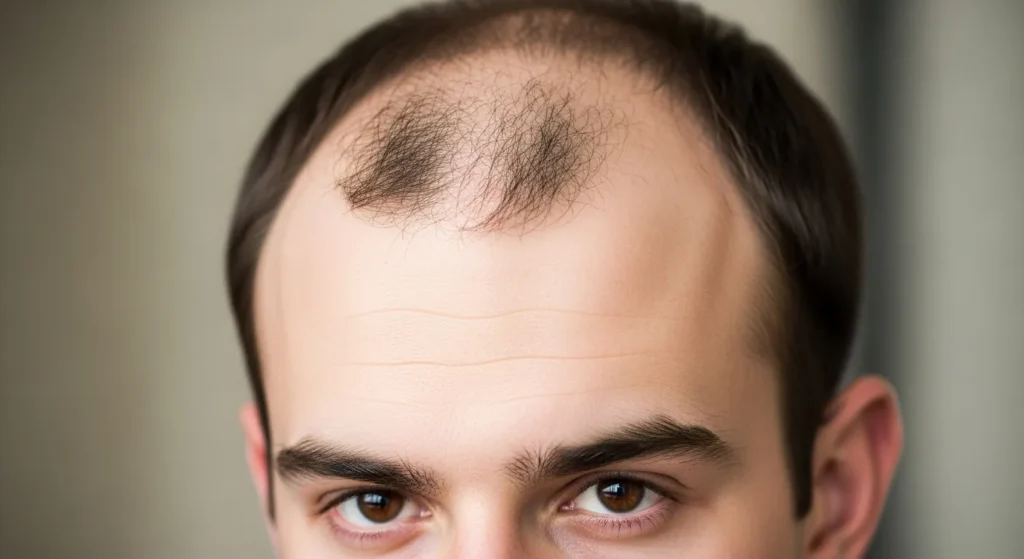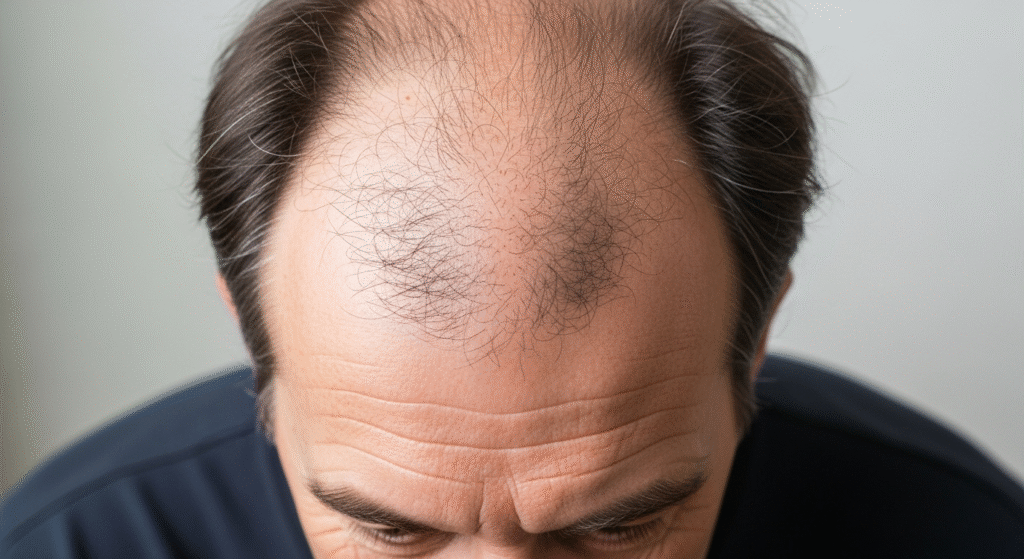Balding at a young age can feel both confusing and frustrating, especially when your peers still have full heads of hair. Whether you’re 18 or 28, balding at a young age is more common than you might think.
In this guide, we’ll uncover what causes it, how to treat it, and when to seek professional help. You’ll also learn proven strategies to manage early hair loss and feel confident again. Backed by expert insight and practical tips, this article is your roadmap to reclaiming control over your hair health.

Why Am I Balding So Young?
Losing hair in your teens or twenties isn’t just about vanity — it often points to underlying biological, genetic, or lifestyle factors. Understanding what’s triggering your early hair loss is the first step toward finding the right solution.
Understanding Male and Female Pattern Baldness in Youth
Androgenetic alopecia, also known as male or female pattern baldness, is the most common cause of hair loss at a young age. It typically follows a hereditary pattern, with men noticing a receding hairline or thinning crown, and women experiencing diffuse thinning.
The Role of Genetics and Family History
If early balding runs in your family, there’s a higher chance you’ll experience it too. Genetic sensitivity to dihydrotestosterone (DHT), a byproduct of testosterone, can cause hair follicles to shrink and eventually stop producing hair.
Hormonal Imbalances
Conditions like thyroid dysfunction, PCOS (in females), or sudden hormonal shifts can trigger premature hair loss. DHT overproduction is also a major hormonal culprit in androgenetic alopecia.
Stress and Lifestyle Factors That Accelerate Hair Loss
High stress levels, poor sleep, smoking, and rapid weight loss can disrupt the hair growth cycle, leading to noticeable shedding or thinning, often referred to as telogen effluvium.
Common Medical Conditions Linked to Early Hair Loss
Hair loss can sometimes signal deeper health concerns.
Alopecia Areata and Autoimmune Triggers
Alopecia areata is an autoimmune disorder where the immune system attacks hair follicles, causing sudden bald patches. It can affect people at any age, including children and young adults.
Nutritional Deficiencies
Lack of essential nutrients like iron, vitamin D, zinc, or biotin can impair healthy hair growth. Crash dieting or poor eating habits are common causes among young individuals.
Impact of Chronic Illnesses or Medications
Diseases like lupus or diabetes, and certain medications (antidepressants, chemotherapy, blood pressure drugs), may also contribute to early-onset balding.
Psychological and Emotional Impact of Early Balding
Balding can take a serious emotional toll, especially on young people navigating school, careers, and relationships.
Loss of Confidence and Self-Esteem
Hair is closely tied to identity. Losing it prematurely can lead to social withdrawal, anxiety, and even depression.
Social Stigma and Peer Pressure
Unfortunately, society still views hair as a sign of youth and vitality. Early balding may trigger teasing or feelings of inadequacy.
Seeking Support and Mental Health Guidance
Talking to a counselor or joining support groups can be helpful. Emotional well-being is just as important as physical treatment.
Effective Treatment Options for Young People Experiencing Hair Loss
Good news — early intervention often leads to better results. Several safe and effective treatments are available for young adults.
FDA-Approved Treatments: Minoxidil and Finasteride
- Minoxidil: A topical solution that stimulates hair growth and is available over the counter.
- Finasteride: A prescription oral medication that reduces DHT levels, slowing hair loss and promoting regrowth in men. Not recommended for women of childbearing age.
PRP Therapy
Platelet-Rich Plasma (PRP) involves injecting your own blood plasma into the scalp to stimulate dormant hair follicles. It’s gaining popularity for early-stage hair loss.

FUE Hair Transplant for Younger Patients
Follicular Unit Extraction (FUE) is a minimally invasive surgical option. While highly effective, it’s generally best for those with stabilized hair loss patterns. Consult a qualified hair transplant surgeon before considering it.
Emerging Therapies
Innovative options like microneedling, stem cell therapy, and low-level laser therapy (LLLT) show promise for early intervention. However, they require further clinical validation.
Natural Remedies and Hair Care Tips
Not ready for medications or treatments? Start with these natural, hair-friendly practices.
Best Oils, Shampoos, and Scalp Care
- Use gentle, sulfate-free shampoos
- Massage the scalp with oils like rosemary, coconut, or castor oil
- Avoid excessive heat styling or tight hairstyles
Diet and Supplements for Hair Growth
- Include protein-rich foods like eggs, nuts, and fish
- Supplement with biotin, iron, or vitamin D (after checking levels)
- Stay hydrated and avoid junk food
Habits to Avoid That Damage Hair
- Overwashing or harsh towel drying
- Smoking, which reduces scalp circulation
- Skipping regular scalp hygiene
When to See a Hair Loss Specialist
Acting early can save you from irreversible hair loss.
Signs It’s More Than Just Seasonal Shedding
- Widening part or receding hairline
- Clumps of hair in the shower or on your pillow
- Bald patches or overall thinning
Early Diagnosis = Better Outcomes
Hair loss is most treatable in its early stages. A certified trichologist or dermatologist can diagnose the cause and recommend tailored treatments.
What to Expect During a Hair Loss Consultation
- Medical history review and scalp examination
- Blood tests for hormonal or nutritional deficiencies
- A discussion of treatment goals and available options
Expert Tips for Coping and Managing Early Balding
Dermatologist’s Advice on Prevention and Maintenance
According to Dr. Rana Irfan (ABHRS and ISHRS-certified surgeon), “Identifying the root cause early — whether it’s hormonal or lifestyle-related — makes all the difference. Combining medical and supportive therapies yields the best outcomes.”
Hair regrowth is a slow process. Most treatments require 3–6 months before noticeable results. Be patient and consistent.

Frequently Asked Questions (FAQs)
Q: Can hair loss at 18 or 20 be reversed?
A: Yes — if caught early and properly treated with lifestyle changes, medication, or therapies like PRP.
Q: Is balding at 25 too early for a transplant?
A: Not necessarily, but it’s crucial to assess if your hair loss pattern has stabilized. Consult a qualified surgeon.
Q: Does wearing caps cause early hair loss?
A: No, that’s a myth. Tight hats may cause minor breakage, but don’t affect follicle health.
Q: Is balding at a young age permanent?
A: It depends on the cause. Genetic hair loss may progress over time, but many forms are reversible with treatment.
Ready To Next Step
If you’re struggling with balding at a young age, don’t wait for it to get worse. Book a consultation with Dr. Rana Irfan in Islamabad — a trusted hair restoration expert certified by ABHRS. Get a personalized hair loss diagnosis and treatment plan designed just for you. Your confidence starts with one step. Reach out today!
